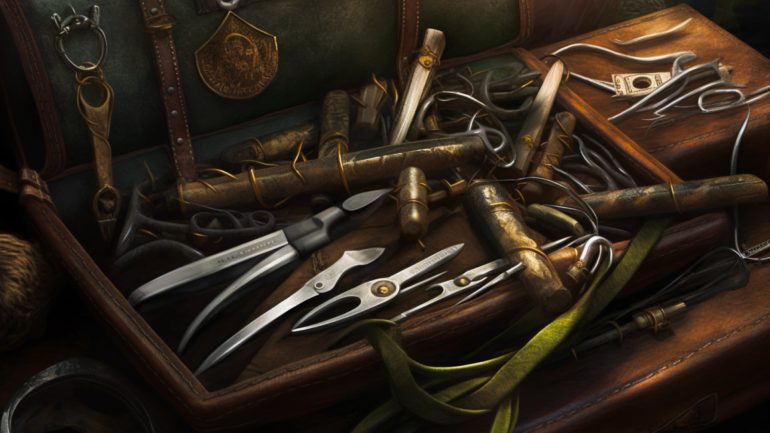If you’ve played Dungeons and Dragons 5E, read the Player’s Handbook, or even seen a stream or two then you’ve likely come across Thieves’ Tools (PHB, p. 154) and may have some questions. Well, you sailed into the right cove!
What are Thieves’ Tools?
Thieves’ Tools are a collection of useful implements that can be called upon for many reasons in play, the full set of tools consist of:
- A set of lock picks
- A small file
- A pair of narrow-bladed scissors
- A pair of pliers
- A small mirror on a metal handle (similar to a dental mirror)
Many people just consider Thieves’ Tools as nothing more than a set of lock picks, but when you consider what the set includes it can open up new possibilities for you as a player, more on that next.
What can Thieves’ Tools do
Your DM can call for a Thieves’ Tools check, which usually but not always uses your Dexterity modifier, for a number of things. The most common are:
- Picking a lock, where the DC can be modified by how complex it is or if it is enchanted, for example, by the Arcane Lock spell.
- Disabling a trap
- Setting up a trap of your own, this uses rules found in Xanathar’s Guide to Everything on pg. 84. To do so requires a short rest and the resulting trap’s DC is set by the result of your Thieves’ Tools check.
However, knowing what your tools consist of allows you to be creative, DM permitting of course. Here are some examples of non-typical uses:
- Using the small mirror to look under doors and around corners.
- Filing the teeth of a key so it will no longer work.
- Cut a chunk out of the Bard’s hair with your scissors.
The limits are your own imagination and your party’s tolerance for your shenanigans!
How to get Thieves’ Tools proficiency
Now we’ll list all of the ways you can get proficiency in this set of tools, where a class is listed they gain proficiency at level 1:
- Artificer
- Rogue
- Criminal (background)
- Urchin (background)
- Urban Bounty Hunter (SCAG background)
- Prodigy (racial feat exclusive to humans, half-elves, and half-orcs)
- Skilled (feat)
- Decadent Mastery (githyanki racial feature)
- Tireless Precision (vedalken racial feature)
- Specialized Design (warforged racial feature)
Note: You can gain Thieves’ Tools on any background by customizing it using the rules outlined in the PHB. In addition to this, if using TCoE race rules you can swap any tool proficiency from your race for one of your choice.
Hopefully, this article helped you feel like a smooth criminal and you won’t blame us too harshly for the beat now playing in your head. If you’re interested in rogueish characters then check out our Rogue 5E guide, or if you want to know how to get away from what’s behind that locked door, then check out our Dash breakdown. Until next time, remember to ask for Guidance before you try to disarm that trap!






